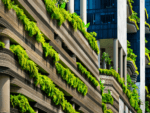Earth Month continues with a look at the commercial real estate sector, where strides are being made in reducing the industry’s collective carbon footprint, particularly in Class-A office buildings in top-tier cities. Investors, developers, managers, and corporate tenants throughout the country have embraced the concept of sustainability—due in large part to the efforts of the U.S. Green Building Council (USGBC) and its Leadership in Energy & Environmental Design (LEED) rating system, the standard by which all commercial space is measured.
The best sustainable architecture goes far beyond a few rooftop solar panels. Let’s take a look at three standard-setting buildings across the country.
The Bank of America Tower in New York City, which earned the U.S. Green Building Council’s LEED Core & Shell Platinum certification, has sustainability in its DNA. The building uses an onsite natural gas-fueled power plant to provide 70 percent of annual electrical power needs. In a process called cogeneration, waste heat from the power plant is used to make steam that powers chilling machines to cool the building and hot water for heating.
Sloping exterior walls are both stylish and eco-friendly, as they admit sunlight into the interior spaces and more effectively capture rainwater for collection and use. The rainwater collected on roofs is used for cooling purposes and for flushing toilets, saving about 100 million gallons of water per year.
The Robert Redford Building in Santa Monica, California uses 60 percent less water than a standard building of its size. The greywater system filters rain, shower, and sink water to irrigate landscaping and flush toilets. It reduces electricity consumption 60 to 75 percent by maximizing natural light and using efficient fixtures and appliances, task lighting, dimmable electronic ballasts, occupancy sensors, and extra insulation. After a full renovation, 98 percent of the leftover materials from dismantling the original building and constructing the new one were reused or recycled.
Schools are getting in on the green movement as well, led by the Adam Joseph Lewis Center for Environmental Studies located on the campus of Oberlin College in Ohio. The building uses a closed-loop groundwater heat pump system, which includes 24 geothermal wells used for heating and cooling. More than 4,000 square feet of photovoltaic panels cover the roof and parking pavilion to capture the renewable energy from the sun. When more energy is collected than is being consumed, it exports the energy back to the grid.
The landscaping surrounding the building is an important part of the center. The specially engineered wetland called the Living Machine purifies non-potable wastewater for reuse in toilets and the landscape. An orchard and permaculture garden also serve as a living exhibit on urban agriculture. Check out this real-time dashboard to see what the building is doing right now!
We have a long way to go, but industry and businesses are taking the steps to improve their environmental footprint, seeing not only the environmental benefits but also the financial benefits of going green. Distinguished Programs supports the green efforts being implemented by the hospitality industry and others. We have enriched our insurance program by supporting those that implement environmental initiatives through AGPOM (Association of Green Property Owners and Managers). AGPOM is a 501(c)(6) non-profit organization that helps property owners and managers realize the value of environmental-friendly pursuits while offering incentives that stimulate participation. For more ways to implement green behaviors in your office building, see the AGPOM Green Property Plan for Office Buildings.




